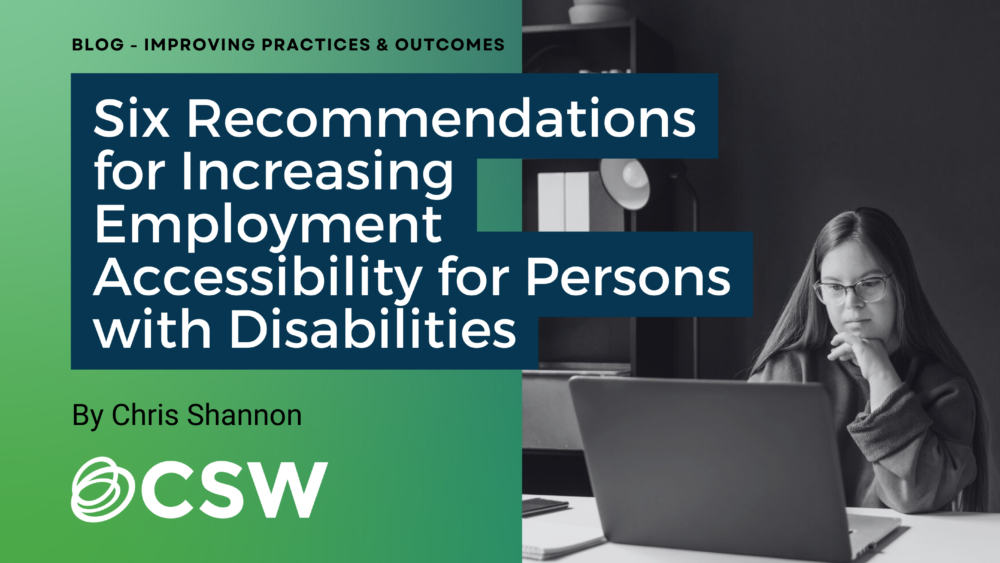Despite a lower-than-average state labor force participation rate, Michiganders with disabilities are strikingly underemployed, representing an untapped labor pool for Michigan’s business community. As of August 2023, Michigan’s labor force participation rate was 61.3%; Michigan currently ranks 40th in the Nation in labor force participation. It is anticipated that Michigan’s labor force participation rate will only continue to decline, due in part to an aging population and out-of-state migration, especially among Michigan’s 18–34-year-olds. It will only get harder to find workers over the next 20 years.
Yet persons with disabilities (PWD) who want to work still meet challenges in accessing employment. In 2022, the employment-population ratio for PWD at its highest point was only 34.8%, while the ratio for persons without a disability for the same age group was 74.4%. The unemployment rate for persons with disabilities was more than twice that for those without a disability—7.6% versus 3.5%. This inequity could be the byproduct of pervasive biases and assumptions that still follow PWD, like, “Persons with disabilities who receive government assistance aren’t motivated to work” and “Anyone with a disability who wants a job has one.”
Our recent research disagrees. During the summer of 2023, we held a series of focus groups to hear directly from those impacted. We learned that persons with disabilities want to work, with many of the focus group participants describing themselves as unemployed or underemployed. What motivates them to work would resonate across demographics. Twenty-four percent explicitly cited “independence” as a key motivator; for some that meant independence from the Supplemental Security Income (SSI) system and living in forced poverty. For others, it meant moving away from dependence on aging parents. But for most, it was personal pride—they want to be self-reliant.
Focus group participants expressed a desire to utilize their experience, skills, and expertise, and to enhance the bottom line of a business or organization. They want to be valued for their abilities. For some, a job also represented a chance to belong, to be a part of a community. Anyone who has experienced unemployment can relate to these motivations.
Study after study demonstrates that PWD are a valuable source of labor talent. From wheelchair-bound security guards to coders with autism, these workers bring unique skills, improve workplace culture, and draw in new customers. Yet these workers face considerable challenges accessing employment opportunities. Although some of these challenges are policy-based, there are simple changes employers can make to make themselves more attractive and accessible to this diverse talent pool.
As an employer, you can help minimize barriers to employment for persons with disabilities and deepen your commitment to an inclusive workplace. Here are a few ideas to get you started:
1. Review your job descriptions for ableist language or job requirements not necessary for the role.
Ableism is a form of discrimination that favors people who don’t have disabilities over people who do. Ableist language refers to any word or phrase that devalues people who have a disability. Job descriptions can contain ableist language that can inadvertently make candidates feel excluded. For example, one might use the phrase “this job requires you to be on your feet” to convey a fast-paced work environment or “able to see blindspots in a logic model” to describe a desired trait in a candidate. If you are unsure if your job description contains ableist language, you can use free online resources like the U.S. Department of Labor’s Ableist Language Detector and fee-based online services like Our Ability and Textio.
2. Focus more on skills in your job descriptions.
Focusing on skills that are essential to the job can reduce barriers, decrease ableist language, and increase candidate diversity. Consider removing anything that isn’t truly essential to perform the job such as:
- must have a valid driver’s license (for jobs that don’t center on driving);
- requires the ability to sit for extended periods of time; or
- must be able to lift 30 pounds (for an office job).
Removing non-essential descriptors in job postings can not only help limit ableist language, but this practice can also remove unintentional barriers to employment. For example, a job that requires someone to be able to get to external meetings does not necessarily require a driver’s license or owning a vehicle. Finally, focusing on skills, instead of in-field experience or high education credentials, can open alternative pathways into your organization and further diversify your talent pool. Skills-based hiring reaps other rewards as well, like a decrease in cost-to-hire, a decrease in time-to-hire, and a reduction in mis-hires.
3. Ensure your websites are fully accessible and compliant with ADA standards.
Compliance with the Americans with Disabilities Act (ADA) isn’t just for your office or worksite—it applies to your websites as well. Webpages that host job postings and online application portals can pose unintentional barriers to persons with disabilities, marginalizing a source of rich talent. Inaccessible websites affect not just people with vision or hearing impairments but also people who have difficulty using a keyboard or mouse. Timed assessments in the application process and complex website navigation paths can pose challenges to people with learning or cognitive disabilities. It is critical to provide a flexible user experience.
4. Consider partnering with a local organization or state agency that serves persons with disabilities to create more inclusive job interview procedures.
One business we interviewed partners with a local organization to source persons with disabilities for open positions. When asked what accommodations were requested by this population, they said only one: candidates requested having service provider staff sit in on the interview. The business admitted that having organization staff model an inclusive approach to interviewing was a great development opportunity for hiring managers and improved their interviewing practices across the company. A service provider could also advise on promoting accessibility throughout the recruitment process, such as including contact information for technical support on your website or simple steps to request an accommodation with your job postings and on your application portal.
5. Create longer training onramps into open positions.
Longer onramps into a position better acclimates an applicant to the job duties, job demands, and corporate culture; they also provide a more intentional training and onboarding process. The result is a better-prepared new hire and more successful job performance. This approach often benefits from a partnership with a workforce development, educational, or training program. You can build off existing work-based learning models, such as registered apprenticeships, informal apprenticeships, cooperative education, paid internships, and provisional hiring.
6. Norm the conversation about accommodations.
Don’t make new hires approach you for accommodations; integrate that conversation as part of your onboarding process for all new hires. Most of the accommodations desired by the focus group participants represented no cost to a company yet allowed them to be their best selves at work. Some examples include the ability to flex hours when needed, the opportunity for remote work, short breaks from sitting for long periods, and regular feedback from managers. A simple question of, “How can I help you be your best self at work?” is a great way to begin that conversation.
We want to hear from you! What else can employers do to ensure their recruitment, hiring, and onboarding processes are inclusive of all abilities?

Meet the Author
Chris Shannon
Chris is a Senior Policy Associate with CSW’s Improving Practices and Outcomes Team. Chris supports systems change and transformation by developing organizational capacity through learning conversations, data analysis, and promoting shared insights to benefit systems. Continue Reading >>



Comments are closed.